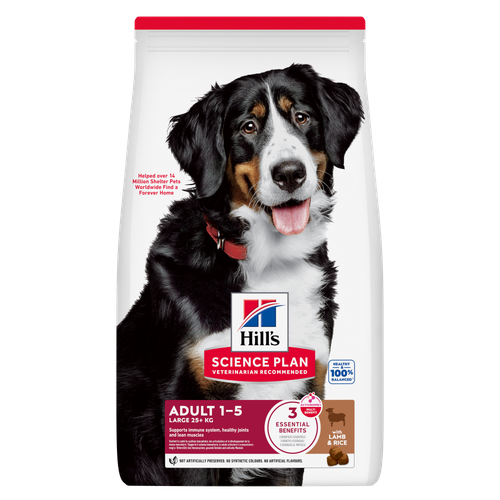
-
Find the right food for your petTake this quiz to see which food may be the best for your furry friend.Find the right food for your petTake this quiz to see which food may be the best for your furry friend.Featured products
 Adult Light Dog Food
Adult Light Dog FoodHill's Science Plan Light Adult Wet Dog Food is a complete premium pet food for adult dogs that tend to gain weight easily. This deliciously smooth loaf is formulated to deliver the appropriate amount of energy to support weight maintenance in adult dogs.
Shop Now Perfect Digestion Large Breed Puppy Food
Perfect Digestion Large Breed Puppy FoodPrecisely balanced nutrition with Hill's ActivBiome+ prebiotic blend actively contributes to supporting digestive health and overall wellbeing to help your pet feel their best
Shop Now Large Breed Adult Dog Food
Large Breed Adult Dog FoodHill's Science Plan Large Breed Adult Dog Food with Lamb & Rice is a complete pet food, specially formulated with ActivBiome+ Multi-Benefit Technology.
This food is specifically designed to fuel the energy needs of large breed dogs during the prime of their life.Shop NowFeatured products CULINARY CREATIONS ADULT CAT FOOD
CULINARY CREATIONS ADULT CAT FOODHill's Science Plan CULINARY CREATIONS Adult cat food with Salmon & Carrots was formulated to provide a great-tasting experience to cats. Its delicious flavour and texture are combine with essential nutrients to support cats' optimal health during the prime time of their life. Specially formulated with high-quality salmon protein, essential taurine for heart health & balanced minerals to support kidneys & bladder.
Shop Now Sterilised Adult Cat Food
Sterilised Adult Cat FoodHill's Science Plan Adult Sterilised Cat Dry Food with Salmon is specially formulated with ActivBiome+ Multi-Benefit Technology. It is a precisely balanced nutrition, tailored to meet the needs of sterilised cats, to help keep sthem lean & healthy.
Shop Now Adult Cat Food
Adult Cat FoodHill's Science Plan Adult Cat Food with Chicken is a complete pet food, specially formulated with ActivBiome+ Multi-Benefit Technology.
This food is specially formulated to fuel the energy needs of cats during the prime of their life.Shop Now -
Dog
- Dog Tips & Articles
-
Health Category
- Weight
- Food & Environmental Sensitivities
- Urinary
- Digestive
- Joint
- Kidney
-
Life Stage
- Puppy Nutrition
- Adult Nutrition
- Senior Nutrition
Cat- Cat Tips & Articles
-
Health Category
- Weight
- Skin & Food Sensitivities
- Urinary
- Digestive
- Kidney
-
Life Stage
- Kitten Nutrition
- Adult Nutrition
Featured articles Microchipping: The Facts | Hill's Pet
Microchipping: The Facts | Hill's PetThe government has announced that as of April 2016, all dogs in the UK must be microchipped by law.
Read More The Incredible Science Behind Your Pet's Microbiome
The Incredible Science Behind Your Pet's MicrobiomeLearn what your pet's microbiome is, how it contributes to your pet's gut and overall health, and why nutrition is important in maintaining healthy microbiomes.
Read More Pet Nutrition: What Makes "Healthy" Pet Food Healthy? | Hill's Pet
Pet Nutrition: What Makes "Healthy" Pet Food Healthy? | Hill's PetIn people, the right diet is very important. If you are eating the wrong way for your metabolism, activity level, age and lifestyle you could end up with health issues.
Read More -


One new dog at a time is challenging enough for most pet parents, and experts don't recommend adopting two puppies at once. But if you've already brought home two puppies, you can double the fun with the right training and socialisation techniques.
Are you ready to find out how to train two dogs at once? Let's learn how here.
Training Two Puppies: What Could Go Wrong?
There’s no doubt that it's more difficult to adopt two puppies at once. But by understanding and anticipating the special challenges ahead of time, owners can train and socialise both dogs to be amazing family pets.
Along with the practical considerations of adopting two puppies (How expensive will vet care be? Do I have room?) raising them has some special challenges:
Two puppies are more likely to bond to each other, rather than to their new human family.
Puppies adopted together might be anxious or timid when separated.
Dogs are individuals, so each puppy will learn and train at their own speed.


Tasty Tips
Training Strategies
If you have adopted two puppies, there are steps you can take to prevent behaviour issues and help with training multiple dogs at once. Many of these suggestions involve the puppies spending time independently:
Crate the dogs separately at night. Crate training helps with safety, damage control, house training, and travelling. Your new puppies should be crated separately and kept close enough for you to hear them at night if they need you.
Train them individually. When training two puppies, the dogs should attend training classes separately. Alternatively, if you're training at home, work with one dog while the other is with a human family member in a separate room or has a food dispensing toy to keep them occupied. You can also put each puppy on a long, comfortable lead outside to get them used to watching each other receive attention.
Socialise and play with them separately. This creates puppy independence and lets the more timid dog play without competing for your attention. You can try taking one puppy at a time with you on a short outdoor errand, or bring them over to a puppy-proofed friend's house for a meet-and-greet.
Walk them one at a time. Give each dog your undivided attention on their own daily walk. Even with separate handlers, if you always walk your puppies together, the less confident puppy will come to rely on the presence of the other dog for confidence and security. This also gives each puppy time to sniff and meet other dogs in their own way.
You're not trying to keep these two potential best friends apart from one another. Rather, you're just giving them each their own space to be who they are as they develop into well-adjusted adult dogs. As you start to understand their independent personalities and where each one shines, you can start to incorporate more group activities that allow them to train as one. Just always make sure to give each one their own share of love and attention, so that your attention doesn’t become a scarce resource that triggers squabbles or even more serious fights. Training two puppies just requires extra diligence in ensuring that each puppy is given equal attention.
A Tail of Two Dogs
You should always consider the time commitment and care costs of a new furry friend before you adopt. That’s even more important if you’re bringing home two! If you do decide to double down on dogs, you can succeed by treating them as individual personalities, by properly training them, and by spending time with them around people and other dogs. Taking these steps will help bond your dogs to you for life and put a foundation into place that helps your new puppies wiggle their way into a happy, well-adjusted life as the newest members of your family.


Kara Murphy is a freelance writer and pet parent who lives in Erie, Pa. She has a goldendoodle named Maddie.
Related products

Hill's Science Plan Adult Wet Dog Food with Turkey is a complete premium pet food for adult dogs from 1 year. This deliciously smooth minced turkey loaf is formulated to deliver the appropriate amount of energy to support the needs of adult dogs.

Hill's Science Plan Large Breed Adult Dog Food with Lamb & Rice is a complete pet food, specially formulated with ActivBiome+ Multi-Benefit Technology.
This food is specifically designed to fuel the energy needs of large breed dogs during the prime of their life.

Precisely balanced nutrition with Hill's ActivBiome+ prebiotic blend actively contributes to supporting digestive health and overall wellbeing to help your pet feel their best

Hill's Science Plan Light Adult Wet Dog Food is a complete premium pet food for adult dogs that tend to gain weight easily. This deliciously smooth loaf is formulated to deliver the appropriate amount of energy to support weight maintenance in adult dogs.
Related articles

Learn to see the signs of an upset stomach in your dog, understand the triggers and explore some possible solutions.

Dog obesity is a significant problem - learn more about helping your dog become trimmer and healthier through improved nutrition.
Discover the causes, signs, and treatments of kidney disease in dogs and find methods of supporting your dog's kidney health. Learn more at Hill's Pet.

Gurgling tummies in turmoil are not good news for pets. Owners who have to clean up the unfortunate consequences, digestive problems are one of the rare downsides to owning a pet.

Put your dog on a diet without them knowing
Our low calorie formula helps you control your dog's weight. It's packed with high-quality protein for building lean muscles, and made with purposeful ingredients for a flavourful, nutritious meal. Clinically proven antioxidants, Vitamin C+E, help promote a healthy immune system.
Put your dog on a diet without them knowing
Our low calorie formula helps you control your dog's weight. It's packed with high-quality protein for building lean muscles, and made with purposeful ingredients for a flavourful, nutritious meal. Clinically proven antioxidants, Vitamin C+E, help promote a healthy immune system.

